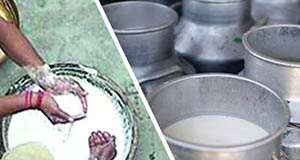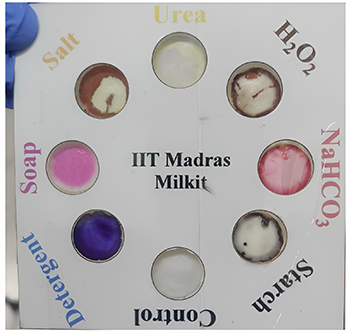SHIMLA/CHENNAI: The growing menace of milk adulteration in India or world will soon be a thing of the past!.
Next time the milk producers or milkmen or milk marketeers, milk shake and juice makers, even mineral water walas resort to adulteration, they will be caught in 30 seconds!
Researchers at IIT Madras has developed a handy device to detect adulteration in milk in just 30 seconds at home itself.
Not only adulteration in milk, but the consumers can test other liquids such as water, fresh juices and milkshakes for traces of adulteration.
IIT researchers have developed a three-dimensional (3D) paper-based portable device that can detect adulteration in milk within 30 seconds.
The test could be even performed at home, reveal the IIT spokesperson.
This device can detect multiple substances commonly used as adulterating agents.
These include Urea, detergents, soap, starch, hydrogen peroxide, sodium-hydrogen-carbonate and salt and others.
Milk is one of the most vital foods important to lead a healthy lifestyle.
Yet it is the most adulterated food item in the world.
The adulteration of milk is a growing menace, especially in developing countries like India, Pakistan, China, and Brazil.
Consumption of adulterated milk could cause medical complications such as kidney problems, infant death, gastrointestinal complications, Diarrhoea, and even cancer.
In contrast, conventional laboratory-based methods to test the purity of milk are both expensive and time-consuming.
Even corruption rules the roost in the government-run testing labs and culprits are never brought to book.
But this new device is both handy and inexpensive
Only a millilitre of any liquid would be as a sample to test the adulterants.
This research was led by Dr. Pallab Sinha Mahapatra, Associate Professor, Department of Mechanical Engineering, IIT Madras, along with Research Scholars Mr. Subhashis Patari and Dr. Priyankan Datta.
They co-authored a Research Paper that has been published in the prestigious peer-review journal Nature.
Dr. Pallab Sinha Mahapatra said, “The 3D paper-based microfluidic device is made up of a top and bottom cover and a sandwich structure middle layer.
“This 3D design works well for transporting denser liquids at a consistent speed. The paper is treated with reagents and is let to dry”.
Both paper layers are adhered to both sides of the support after drying, and the covers adhere with double-sided tape.
“Whatman filter paper grade 4 is used in this design, which aids liquid flow and allows for the storage of more reagents.”
He added, “All the reagents are dissolved either in distilled water or in ethanol, depending upon their solubility”.
Using colorimetric detection techniques, all the adulterants are detected in different liquid samples, he explained.
It is inferred from the investigation that the reagent only reacts with the specific adulterant in this method and not with any milk ingredients.
“Hence, this analytical tool can help to monitor liquid food safety and thereby increases the traceability of tainted milk in remote areas of developing countries.”




